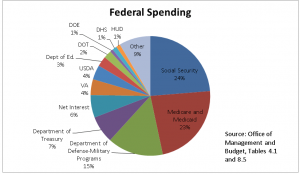For many years, Republicans have been determined to privatize Medicare and Social Security or get rid of the programs altogether. So whenever Republicans talk about federal spending, they usually show a chart that looks something like this:

Notice that the two largest slices of the budget represent Social Security, Medicare and Medicaid, or what is often called “mandatory” federal spending. Thus, the chart would seem to indicate that most of the tax revenue goes toward healthcare and retirement for the elderly and the poor. Is it any wonder, then, that so many young people believe that the federal government is being “bankrupted” by payments to senior citizens?
However, most of the costs for Medicare and Social Security are not part of the general budget.
Medicare and Social Security are, in fact, insurance programs similar to your auto, health and household insurance policies. And, like your other insurance policies, the premiums for Medicare and Social Security are collected each year of your working career so the benefits will be there when you need them. The premiums are deducted from our paychecks – you know, the ones that are labeled FICA (Federal Insurance Contributions Act) and Medicare. As a result, Medicare and Social Security are “entitlements” only in the sense that once you have paid the premiums, you are entitled to the benefits in much the same way you’re entitled to benefit from claims against your Allstate, GEICO, Progressive or State Farm policies.
Since the programs pay for themselves, their budgets should be kept entirely separate from the general budget. To more accurately reflect reality, the federal spending chart should look like this:

This chart represents the spending controlled by Congress and paid for through taxation. As you can see, in this chart, the majority of that spending is for our military ($824.6 billion, up more than 13 percent since Republicans have taken the reins of government) and veteran’s benefits ($78.9 billion). When Congress spends more on these items than it collects in taxes, it results in deficit-spending. The shortfalls result in borrowing from other sources – from other countries and from the Medicare and Social Security trust funds.
Despite their claims to the contrary, Republicans have been particularly good at deficit spending. Reagan nearly doubled the federal debt, increasing it by $1.9 trillion. George W. Bush increased the debt by $5.8 trillion. He also left his successor with two wars and the Great Recession resulting in more than $8.5 trillion of additional borrowing. And, in his first two years in office, Donald J. Trump has already doubled the deficit, increasing the debt by more than $1.2 trillion. And the 10-year cost of the Trump tax cuts will add an estimated $2.3 trillion more to the federal debt.
In order to reduce the debt, Senate Majority Leader Mitch McConnell says he wants to balance the federal budget by cutting payments to “entitlements,” aka Social Security, Medicaid and Medicare.
Say what????!!!!
That would be akin to embezzling money from your employer to pay for your own spending excesses. The Social Security and Medicare trust funds are not Congress’s money!
None of this is to say that Medicare and Social Security don’t have their own problems. If changes are not made, it’s expected that Medicare will exhaust its reserves by 2028. Likewise, it’s expected that Social Security will not be able to meet its full obligations after 2034. But that does not mean that there will be no money left for the programs’ beneficiaries. It simply means that the payouts will be less.
And both programs could meet their obligations with a few tweaks.
Like all insurance programs, they should be governed by actuarial tables. When the costs go up, so should the premiums. Unfortunately, Congress has put limits on the amount of money the programs can charge for premiums. For example, FICA deductions only apply to the first $128,400 of an individual’s income. Social Security could be fixed by simply removing the cap. It’s that simple.
Similarly, Medicare’s impending problems could be solved by increasing the payroll deductions, by negotiating for better prices with pharmaceutical companies, or, better yet, we could improve outcomes while saving our government and our citizens trillions of dollars by moving toward universal health care.
And, here’s a radical idea: Maybe we could find additional money for these programs in the general budget by holding government contractors accountable. For example, the F-35 fighter jet program was $163 billion over budget as of 2014. A figure that continues to climb faster than the plane.
